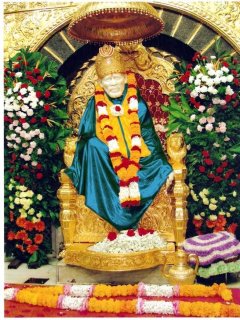Sai Baba

Sai Baba of Shirdi, also known as Shirdi ke Sai Baba, was an Indian guru, yogi, and fakir who is regarded by his Hindu and Muslim devotees as a saint. Many Hindu devotees — including Hemadpant, who wrote the famous Shri Sai Satcharitra — consider him an incarnation of Lord Krishna while other devotees consider him as an incarnation of Lord Dattatreya. Many devotees believe that he was a Satguru, an enlightened Sufi Pir, or a Qutub. No verifiable information is available regarding Sai Baba's birth and place of birth.
The name 'Sai Baba' is a combination of Persian and Indian origin; Sāī (Sa'ih) is the Persian term for "holy one" or "saint", usually attributed to Islamic ascetics, whereas Bābā is a word meaning "father" used in Indian languages. The appellative thus refers to SaiBaba as being a "holy father" or "saintly father". His parentage, birth details, and life before the age of sixteen are obscure, which has led to a variety of speculations and theories attempting to explain the SaiBaba's origins. In his life and teachings he tried to reconcile Hinduism and Islam: SaiBaba lived in a mosque, was buried in a Hindu temple, practised Hindu and Muslim rituals, and taught using words and figures that drew from both traditions. One of his well known epigrams says of God: "Allah Malik" ("God is Master").
Sai Baba remains a very popular saint, especially in India, and is worshiped by people around the world. He had no love for perishable things and his sole concern was self-realization. He taught a moral code of love, forgiveness, helping others, charity, contentment, inner peace, and devotion to God and guru. Sai Baba's teaching combined elements of Hinduism and Islam: He gave the Hindu name Dwarakamayi to the mosque he lived in, practiced Hindu and Muslim rituals, taught using words and figures that drew from both traditions, and was buried in Shirdi. One of his well known epigrams, "Sabka Malik Ek " ("One God governs all"), is associated with Islam and Sufism. He always uttered "Allah Malik" ("God is King").
